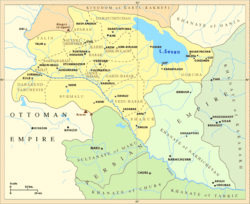
Back Naxçıvan xanlığı Azerbaijani ناخچیوان خانلیغی AZB Kanat de Nakhitxevan Catalan Khanat Nachitschewan German Ĥanlando de Naĥiĉevano Esperanto Kanato de Najicheván Spanish Nahhitševani khaaniriik Estonian خانات نخجوان Persian Khanat de Nakhitchevan French חאנות נחצ'יבאן HE
Nakhichevan Khanate | |||||||||
|---|---|---|---|---|---|---|---|---|---|
| 1747–1828 | |||||||||
 The Nakhichevan and Erivan khanates in c. 1800 | |||||||||
| Status | Khanate Under Iranian suzerainty[1][2] | ||||||||
| Capital | Nakhichevan | ||||||||
| Common languages | Persian (official)[3][4][5] Azerbaijani Armenian Kurdish | ||||||||
| History | |||||||||
• Established | 1747 | ||||||||
• Disestablished | 1828 | ||||||||
| |||||||||
| Today part of | |||||||||
The Nakhichevan Khanate (Persian: خانات نخجوان, romanized: Khānāt-e Nakhjavān) was a khanate under Iranian suzerainty, which controlled the city of Nakhichevan and its surroundings from 1747 to 1828.
The territory of the khanate corresponded to most of the present-day Nakhchivan Autonomous Republic and Vayots Dzor Province of present-day Armenia.[6]
- ^ Bournoutian 2016a, p. xvii.
- ^ Hambly 1991, pp. 145–146.
- ^ Swietochowski, Tadeusz (2004). Russian Azerbaijan, 1905-1920: The Shaping of a National Identity in a Muslim Community. Cambridge: Cambridge University Press. p. 12. ISBN 978-0521522458.
(...) and Persian continued to be the official language of the judiciary and the local administration [even after the abolishment of the khanates].
- ^ Pavlovich, Petrushevsky Ilya (1949). Essays on the history of feudal relations in Armenia and Azerbaijan in XVI - the beginning of XIX centuries. LSU them. Zhdanov. p. 7.
(...) The language of official acts not only in Iran proper and its fully dependant Khanates, but also in those Caucasian khanates that were semi-independent until the time of their accession to the Russian Empire, and even for some time after, was New Persian (Farsi). It played the role of the literary language of class feudal lords as well.
- ^ Homa Katouzian, "Iranian history and politics", Published by Routledge, 2003. pg 128: "Indeed, since the formation of the Ghaznavids state in the tenth century until the fall of Qajars at the beginning of the twentieth century, most parts of the Iranian cultural regions were ruled by Turkic-speaking dynasties most of the time. At the same time, the official language was Persian, the court literature was in Persian, and most of the chancellors, ministers, and mandarins were Persian speakers of the highest learning and ability."
- ^ Hewsen, Robert H. Armenia: a Historical Atlas. Chicago, IL: University of Chicago Press, 2001, map 149.
© MMXXIII Rich X Search. We shall prevail. All rights reserved. Rich X Search